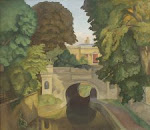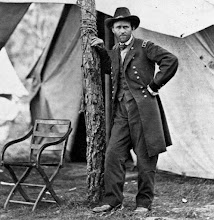Derek Mahon's evocation of a summer-into-fall seaside town in "September in Great Yarmouth" (which appeared in my previous post) reminded me of a poem by C. Day Lewis. The title of the poem refers to the dance (and accompanying music) of that name. This means, I presume, that it is to be read in a sprightly fashion. (How sprightly depends upon whether you are thinking of a folk hornpipe or a hornpipe by Handel or Purcell.)
David Chatterton (1900-1963), "Devon Scene" (1942)
Hornpipe
Now the peak of summer's past, the sky is overcast
And the love we swore would last for an age seems deceit:
Paler is the guelder since the day we first beheld her
In blush beside the elder drifting sweet, drifting sweet.
Oh quickly they fade -- the sunny esplanade,
Speed-boats, wooden spades, and the dunes where we've lain:
Others will be lying amid the sea-pinks sighing
For love to be undying, and they'll sigh in vain.
It's hurrah for each night we have spent our love so lightly
And never dreamed there might be no more to spend at all.
It's goodbye to every lover who thinks he'll live in clover
All his life, for noon is over soon and night-dews fall.
If I could keep you there with the berries in your hair
And your lacy fingers fair as the may, sweet may,
I'd have no heart to do it, for to stay love is to rue it
And the harder we pursue it, the faster it's away.
C. Day Lewis, Word Over All (1943).
The rhyme-scheme of the poem is interesting (and difficult to carry off): in each couplet, there is a word within the middle of the first line which rhymes with a word within the middle of the second line; these two words in turn rhyme with the final word of the first line of the couplet. Thus, for example, in lines 1 and 2, "past" in the middle of line 1 rhymes with "last" in the middle of line 2; "past" and "last" rhyme with "overcast" at the end of line 1. The same pattern (with different rhymes) occurs in the other seven couplets.
In addition, the second and fourth lines of each stanza rhyme. And, for good measure, there is internal rhyming (or near rhyming) within other lines (for instance, "noon" and "soon" in line 12 and "there," "berries," and "hair" in line 13).
David Chatterton, "Vase with Yellow Chrysanthemums"
Friday, September 7, 2012
Subscribe to:
Post Comments (Atom)





2 comments:
Another poet whose work is new to me - loved this poem (and as ever, the accompanying artwork). I have now looked at more of his poems and like what I see.
He chose to be buried close to Thomas Hardy (well, Hardy's heart at least!) in Stinsford churchyard. He is close to his hero in death . . .
Bovey Belle: thank you for that information about Day Lewis's burial place -- I wasn't aware of that. I did know that he admired Hardy from reading his "Birthday Poem for Thomas Hardy," which is a tribute to Hardy both in its content and in the style in which it is written.
As always, thanks for your thoughts.
Post a Comment